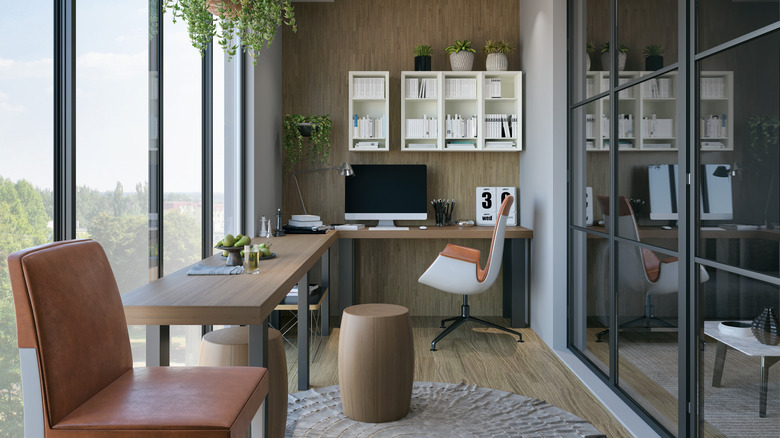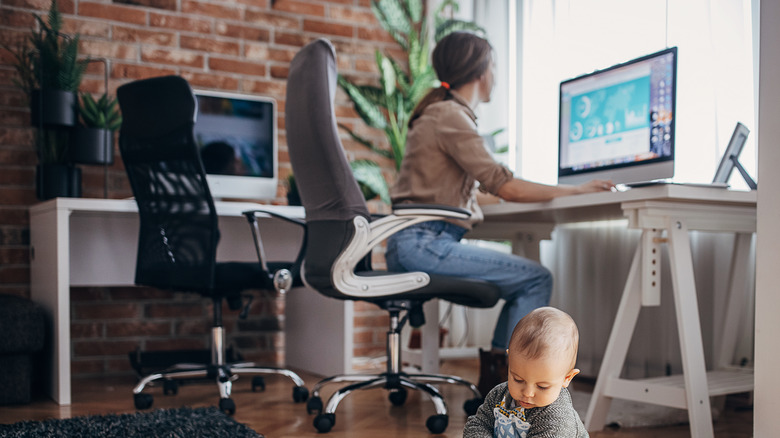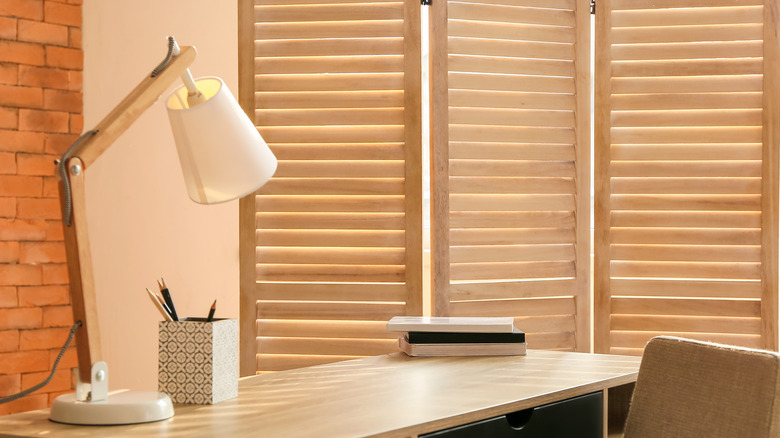Two-Desk Home Office Design Tips That Maximize Space & Functionality
Sharing your home office with your partner, roommate, or child for a couple of days is tolerable at best and mildly annoying at worst. But dealing with them on a regular basis is a whole different ball game. While dealing with a permanent coworker in your home office is no small feat, the biggest challenge will be to share the same space day-in, day-out. Alas, you can't resort to your elementary school self and draw a line down the middle of the room to separate enemy territory from yours (although that might work in certain cases). Following a few design tips, like finding the type of desk that works for the both of you and its placement, will help you maximize space and functionality while keeping your sanity intact.
It's quite simple to design a home office you'll definitely want to work in. Pick a desk you love, choose a decor scheme you resonate with (maximalist bohemianism, anyone?), and display showpieces and plants that get your creative juices flowing. However, the waters become murky when you add another occupant to the mix. Suddenly, you have to take care of their preferences and design choices, too, probably giving your home office a makeover in the process. It isn't all bad. All you have to do is choose a two-desk office layout and designate individual work spaces (a slightly updated and socially acceptable version of the line down the middle of the desk). Easy-peasy!
Tips to pick the right two-desk home office layout
The first step is to focus on the type of desk you want. If your home office is longer than it is wide, the best options are L-shaped desks or dividing a long desk in half (bring out your marker for this one, seriously). Tall offices without much room to expand might be best suited to circular desks or separate standing desks (yes!). Alternatively, if the room is wide enough, go for back-to-back desks — these are mounted on opposite/adjacent sides of the wall and you'll have your back/side to the other person and vice versa. Otherwise, get a T-shaped desk for extra space, or place a desk in the middle of the office and sit facing each other.
After picking the desk, work on its setup. Surprisingly, desk placement isn't just about plopping a big-enough table in the room. Naturally, you wouldn't want to stare at a blank wall, put your back to the door, or risk choosing a suboptimal spot and dealing with screen glare for the better part of a day. If you can't work well sitting across from your partner, you'll need to also adjust your desk layout. Choose a setup that hits the right notes, is near a power outlet, and gives you ample room to work. The desk's material (exquisite marble, dependable wood, laminate, bamboo, and MDF are good options), brand, and color scheme depend on your budget, preferences, and the rest of your home office decor.
Tips to maximize functionality in a two-desk home office layout
After you have the layout and desk setup figured out, it's time to maximize functionality for your two-desk home office. For instance, if one of you takes a lot of video calls, you'll need a clean and clutter-free background. Similarly, if one of you needs an artist-friendly zone to stay focused, will have clients and customers in occasionally, or requires extra storage to house documents, you'll need to work on the decor, keep the room setup flexible, and order storage cabinets beforehand. Remember to keep the agreed-upon layout as the base and make tweaks accordingly.
Determine the gadgets you need individually and ones you'll be sharing. To elaborate, you might need two or three monitors to get your job done while the other person might only need a laptop, so account for the equipment, the space it'll take up, and the locations of chargers in advance. Printers, scanners, and filing cabinets can go in the shared zone, too. Considering your and your colleague's preferred side — right or left — is essential, too.
If you're keen on working without distractions, you might also want to select privacy enhancers like room dividers or floating bookcases. Don't forget to get cable covers, clips, or sleeves to keep the cornucopia of wires and cords organized. If this all seems overwhelming, simply follow the do's and don'ts of decorating an office, according to HGTV star Jeremiah Brent.


